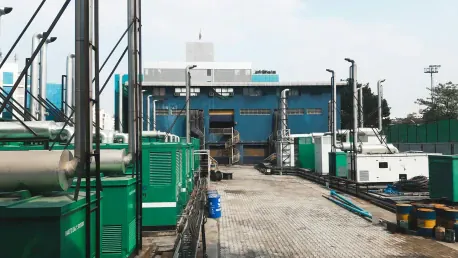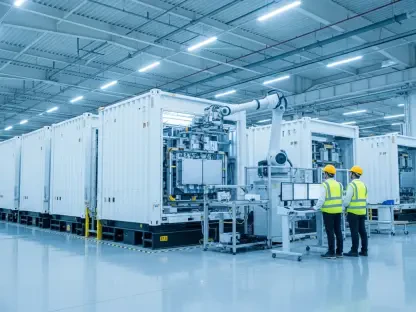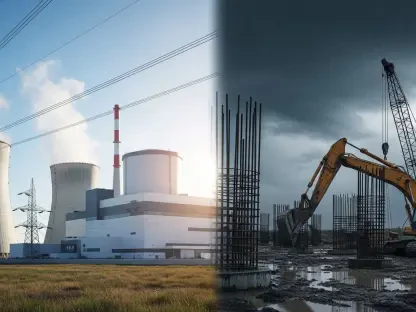The subject of analysis in this article is the testing of EnerVenue’s metal-hydrogen batteries by RWE Clean Energy within a pilot project aimed at determining the viability of this technology for long-duration energy storage (LDES) applications. The initiative underscores the potential of metal-hydrogen batteries to offer a safer, cost-effective, and sustainable alternative to traditional lithium-ion batteries.
Introduction of EnerVenue’s Energy Storage Vessel (ESV)
Emergence of EnerVenue
EnerVenue, based in Fremont, California, entered the market during the pandemic in the summer of 2020 with an innovative alternative chemistry battery technology. These metal-hydrogen batteries were designed as zero-maintenance alternatives that pose no risk of thermal runaway or propagation, thus eliminating dependency on additional fire suppression systems. The Energy Storage Vessel (ESV) promises an impressive lifespan exceeding 30,000 cycles and the capacity to cycle thrice a day without physiological rest. This innovation is critical as it offers a more reliable and safer option compared to conventional battery technologies.
The company’s strategic foray into the market during a challenging time underscores its commitment to revolutionizing energy storage solutions. Their approach is characterized by a focus on safety and efficiency, addressing common issues faced by traditional batteries. Moreover, by ensuring the ESVs do not release any harmful by-products, EnerVenue has positioned itself as a key player in the quest for clean energy. The metal-hydrogen chemistry is particularly notable for its stability and recycling potential, presenting a compelling case for broader adoption in various energy-intensive applications.
Features and Benefits of ESV
The ESVs provide several significant benefits over conventional lithium batteries, including an extended lifespan and customizable configurations that allow for flexible deployment and scaling aligned with architectural demands. EnerVenue asserts that these batteries are highly recyclable, making them an environmentally responsible choice. Furthermore, the zero-maintenance aspect of these batteries eliminates the need for regular check-ups and interventions, thus reducing overall operational costs and complexities.
These metal-hydrogen batteries also boast a high recycling rate, contributing further to their environmental credentials. By promising a lifespan exceeding 30,000 cycles and the capability to cycle thrice daily without requiring rest, the ESVs significantly outpace many current battery technologies in both durability and performance metrics. This makes them particularly attractive for applications requiring consistent and reliable energy output over long periods, which is crucial for integrating renewable energy sources into the grid.
RWE’s Pilot Project and Testing
Objectives and Methodology
In a pilot project located at RWE’s Milwaukee-area testing facility, the energy company is meticulously examining these ESVs by cycling them to study their performance, specifically their cycling flexibility, charge/discharge characteristics, duration, temperature performance, and efficiency. RWE aims to collect data to align EnerVenue’s technology with potential future applications within its renewable energy projects. The methodology involves rigorous testing protocols designed to simulate real-world conditions and stress-test the batteries to their limits.
This comprehensive examination includes monitoring the batteries under various environmental conditions, evaluating their thermal management, and analyzing their efficiency in energy conversion. By doing so, RWE seeks to understand the full spectrum of capabilities offered by EnerVenue’s technology. Such detailed scrutiny is vital in ensuring that these batteries meet the high standards required for integration into grid-scale energy storage solutions. The outcomes will inform potential large-scale deployments, providing invaluable data that could shape future energy storage strategies.
Potential Impact on Renewable Energy Projects
Andrea Hu-Bianco, SVP of engineering at RWE, emphasized the potential of this evolving technology within their energy portfolio, suggesting that successful validation could signify the integration of versatile and scalable energy storage solutions crucial for attaining clean energy objectives. This initiative is driven by the need for grid-scale energy storage that is safe, flexible, and durable to meet growing energy demands and support clean energy goals. The pilot project is not merely a test but a stepping stone towards reshaping the energy storage landscape.
By validating the performance of the ESVs, RWE hopes to facilitate the adoption of this technology across its various renewable projects. The success of this pilot could lead to broader industry uptake, signaling a shift towards more sustainable and reliable energy storage solutions. Such advancements are essential for the transition to a more resilient and green energy grid, capable of supporting the influx of renewable sources like wind and solar power. The implications for energy infrastructure could be profound, enhancing both energy security and environmental sustainability.
Industry-Wide Shift Towards Safer Battery Technologies
Diversification Beyond Lithium-Ion Batteries
The overarching theme here is innovation and validation in energy storage, particularly in diversifying beyond lithium-ion batteries. The trend highlights an industry-wide shift towards exploring safer and more sustainable battery technologies. Guy Moore, RWE’s director of BESS system integration, leads the pilot program which functions as an incubator for both lithium and non-lithium battery technologies. This approach reflects a broader recognition of the limitations and risks associated with traditional lithium-ion solutions, prompting the search for viable alternatives.
This diversification is crucial for the industry’s evolution, as it addresses the pressing need for energy storage solutions that can handle different operational requirements and environmental challenges. By investing in non-lithium technologies like the metal-hydrogen batteries from EnerVenue, companies are paving the way for more versatile and robust energy storage systems. These developments can ultimately lead to a more resilient energy grid, capable of handling the demands of an increasingly electrified and renewable-dependent world.
Collaboration and Technological Capabilities
Majid Keshavarz, CTO of EnerVenue, underlined the collaboration with RWE as an opportunity to showcase their technological capabilities and their potential contribution to clean energy expansion and grid resilience. The outcomes of these tests could significantly impact RWE’s renewable projects and contribute to broader industry trends towards safer, cost-effective, and sustainable energy storage solutions. This partnership exemplifies how collaboration between innovative companies and established energy providers can drive technological advancements.
It also provides a platform for demonstrating the practical applications of emerging technologies in real-world settings, thereby accelerating their adoption. The potential success of this pilot project could serve as a catalyst for further innovations and investments in metal-hydrogen battery technology, highlighting its role in the future of energy storage. As the industry continues to evolve, such collaborations will be instrumental in achieving the dual goals of energy reliability and sustainability, ultimately supporting global climate objectives.
Additional Deployments and Future Plans
Virginia State University Project
In parallel, EnerVenue is planning to deploy its ESVs on the campus of Virginia State University to offer backup power to its multi-purpose center. Dominion Energy Virginia has commissioned a 1.5 megawatt (MW) BESS on the university’s Ettrick campus, prompted by a review process that scrutinized nine non-lithium ion BESS technologies against criteria such as safety, cost, space requirements, technology chemistry, self-discharge rates, and cycle rates. This deployment is indicative of the growing interest in alternative battery technologies for critical infrastructure.
The selection process highlighted EnerVenue’s superior performance in terms of safety and efficiency, paving the way for its technology to be utilized in various high-priority applications. By deploying their ESVs in educational institutions, EnerVenue is not only providing critical backup power but also demonstrating the versatility and reliability of their solutions. This project is poised to offer valuable insights into the practical benefits of metal-hydrogen batteries in real-world scenarios, potentially influencing further deployments in similar settings.
Dominion Energy’s Testimony and Approval
In its testimony to Virginia’s State Corporation Commission, Dominion underscored EnerVenue’s system’s ability to be cycled multiple times daily while maintaining a low self-discharge rate during idle periods, which ensures availability for backup power. Dominion also noted that EnerVenue’s technology could potentially be sited on customer property with a reduced safety equipment footprint. Upon approval by state regulators, the project aims to be operational by the end of 2027. This approval would mark a significant milestone in the broader adoption of metal-hydrogen battery technology.
The commission’s endorsement would validate EnerVenue’s innovative approach and could encourage other institutions and energy providers to consider similar solutions for their energy storage needs. Enhanced backup power capabilities not only improve operational resilience but also contribute to overall energy security. As institutions increasingly prioritize sustainability and reliability, the success of this project could serve as a compelling case study for future investments in similar technologies.
RWE’s Expansion and Renewable Energy Efforts
Current and Future BESS Projects
RWE, a significant player within the renewable energy sector, currently operates approximately 700 MW of battery energy storage system capacity and is in the process of constructing about 1.4 gigawatts (GW) of BESS projects worldwide. The company aims to scale its capacity to 6 GW across the globe by 2030. This expansion includes recent developments such as the groundbreaking of three 150 MW/300 MWh projects in Texas: Crowned Heron 1, Crowned Heron 2, and Cartwheel 1, all of which are expected to be operational next year.
These ongoing projects are part of RWE’s broader strategy to enhance its renewable energy portfolio and support the global transition to cleaner energy sources. By significantly increasing its battery energy storage capacity, RWE aims to address the intermittency issues associated with renewable energy and provide more stable and reliable power supply. This extensive expansion plan illustrates the company’s commitment to leading the charge in renewable energy innovation and infrastructure development, positioning itself as a key player in the global green energy movement.
Offshore Wind Joint Venture and Land Repurposing
The focus of this analysis is on RWE Clean Energy’s pilot project, which tests EnerVenue’s metal-hydrogen batteries to explore their potential for long-duration energy storage (LDES) applications. This initiative aims to evaluate the technology’s feasibility, emphasizing the benefits that metal-hydrogen batteries could bring compared to traditional lithium-ion batteries. Specifically, the project seeks to highlight the advantages of using metal-hydrogen batteries, including their safety, cost-effectiveness, and sustainability. By rigorously testing these batteries, RWE Clean Energy aims to gather crucial data to determine if metal-hydrogen technology can efficiently meet the demands of long-duration energy storage. The pilot project forms part of a broader effort to find innovative solutions for green energy storage, addressing the current limitations of lithium-ion technology, such as safety concerns, high costs, and environmental impact. The outcomes of this pilot project could potentially revolutionize the energy storage industry, offering a more viable and environmentally-friendly solution for the future.









